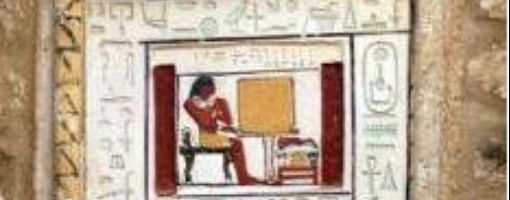Archaeologists unearth two painted tombs in Egypt

Created: Jul 09, 2010,
modified: Jan 13, 2012,
overall rating: 0.000
Two rock-hewn painted tombs, considered as two of the most distinguished tombs ever found from the Old Kingdom were discovered last week at Saqqara Necropolis.
Cultural Minister, Mr. Farouk Hosni, announced today that the tombs were found during a routine excavation carried out by an Egyptian mission at an area called 'Gisr El-Mudir' . It is located to the west of the Step Pyramid of Djoser. The team has been working in this area since 1968.
Dr. Zahi Hawass, Secretary General of the Supreme Council of Antiquities (SCA), who is also the leader of the excavation mission, said that the tombs belong to a father, Shendwa, and his son, Khonsu.
The father’s tomb consists of a painted false door depicting scenes of the deceased seated before an offering table. The door also bears the different titles of the tomb’s owner who was a top governmental official during the Sixth Dynasty (2374-2191 BC). He was the Head of the Royal Scribes and the Supervisor of the Missions as well as holding other honorary titles.
The tomb’s burial shaft is located directly beneath a false door, 20 metres below ground level. When, Dr. Hawass descended into the tomb, he realized that it was intact and had not previously been plundered by tomb robbers.
Unfortunately, Shendwas’s wooden sarcophagus has disintegrated, due to humidity and erosion. Beside the sarcophagus, a collection of limestone jars were found, including five offering vessels carved in the shape of a duck.
Upon opening the vessels, Dr. Hawass discovered that the bones of the ducks were still intact.
Inside the burial shaft, a painted relief and a 30 cm tall obelisk made of limestone were also discovered. “This obelisk is a symbol of worshiping the sun god Re,” said Hawass.
He pointed out that the ancient Egyptians of the Old Kingdom used to erect small obelisks in front of their tombs and inside the temples related to the tombs of the Queens’ pyramids.
Next to the father’s tomb, excavators discovered Shendwa’s son Khonsu. It is a beautifully painted tomb with a false door bearing Khonsu’s different titles.
It appears that Khonsu inherited the same titles as his father. Excavators located an offering table opposite the false door, as well as a stone lintel on the floor.
Hawass said that the lintel is engraved with symbols that belong to the Sixth Dynasty. On top of the false door, is a small lintel depicting a coloured relief of the deceased in different poses.
Global Arab Network
#LISA
Cultural Minister, Mr. Farouk Hosni, announced today that the tombs were found during a routine excavation carried out by an Egyptian mission at an area called 'Gisr El-Mudir' . It is located to the west of the Step Pyramid of Djoser. The team has been working in this area since 1968.
Dr. Zahi Hawass, Secretary General of the Supreme Council of Antiquities (SCA), who is also the leader of the excavation mission, said that the tombs belong to a father, Shendwa, and his son, Khonsu.
The father’s tomb consists of a painted false door depicting scenes of the deceased seated before an offering table. The door also bears the different titles of the tomb’s owner who was a top governmental official during the Sixth Dynasty (2374-2191 BC). He was the Head of the Royal Scribes and the Supervisor of the Missions as well as holding other honorary titles.
The tomb’s burial shaft is located directly beneath a false door, 20 metres below ground level. When, Dr. Hawass descended into the tomb, he realized that it was intact and had not previously been plundered by tomb robbers.
Unfortunately, Shendwas’s wooden sarcophagus has disintegrated, due to humidity and erosion. Beside the sarcophagus, a collection of limestone jars were found, including five offering vessels carved in the shape of a duck.
Upon opening the vessels, Dr. Hawass discovered that the bones of the ducks were still intact.
Inside the burial shaft, a painted relief and a 30 cm tall obelisk made of limestone were also discovered. “This obelisk is a symbol of worshiping the sun god Re,” said Hawass.
He pointed out that the ancient Egyptians of the Old Kingdom used to erect small obelisks in front of their tombs and inside the temples related to the tombs of the Queens’ pyramids.
Next to the father’s tomb, excavators discovered Shendwa’s son Khonsu. It is a beautifully painted tomb with a false door bearing Khonsu’s different titles.
It appears that Khonsu inherited the same titles as his father. Excavators located an offering table opposite the false door, as well as a stone lintel on the floor.
Hawass said that the lintel is engraved with symbols that belong to the Sixth Dynasty. On top of the false door, is a small lintel depicting a coloured relief of the deceased in different poses.
Global Arab Network
#LISA
Your Rating:
Overall rating: 0.000
Totally voted: 0
Comments
Login/Registration
Weather in:
Exchange Rates
1 USD = 16.200 LE
1 EUR = 18.040 LE
News
-
IMF loan expected next month
Apr 22, 2013, rating: 3.000, 3 votes Egypt may secure an International Monetary Fund loan agreement in about amonth, state news agency MENA reported, quoting "informed" sources ...
Egypt may secure an International Monetary Fund loan agreement in about amonth, state news agency MENA reported, quoting "informed" sources ...
-
Egypt population to hit 84 million next month.
Feb 28, 2013, rating: 5.000, 1 votes Egypt's population is expected to reach 84 million on 1 March, or aburgeoning 92 million when Egyptians living abroad ...
Egypt's population is expected to reach 84 million on 1 March, or aburgeoning 92 million when Egyptians living abroad ...
-
Country's diesel reserve only enough for three days.
Feb 05, 2013, rating: 5.000, 1 votes Egypt’s strategic reserve of diesel fuel used for trucks and grouptransport vehicles can meet demand only for three days ...
Egypt’s strategic reserve of diesel fuel used for trucks and grouptransport vehicles can meet demand only for three days ...
-
Egypt received 11 million tourists in 2012 and aims to boost that number to 14 million in 2013.
Jan 22, 2013, rating: 3.000, 2 votes
Egypt received 11 million tourists in 2012 and aims to boost that number to 14 million in 2013.
-
Egypt limits travelers leaving country to US$10,000 in cash
Dec 26, 2012, rating: 3.250, 4 votes Egypt has banned travelers from carrying more than US$10,000 in foreigncurrency cash in or out of the country ...
Egypt has banned travelers from carrying more than US$10,000 in foreigncurrency cash in or out of the country ...
-
National Coalition on Climate Change for Egypt is born
Nov 30, 2012, rating: 5.000, 1 votes The global COP18 conference on climate change opens in Doha Monday.About 17,000 participants from all over the world ...
The global COP18 conference on climate change opens in Doha Monday.About 17,000 participants from all over the world ...








